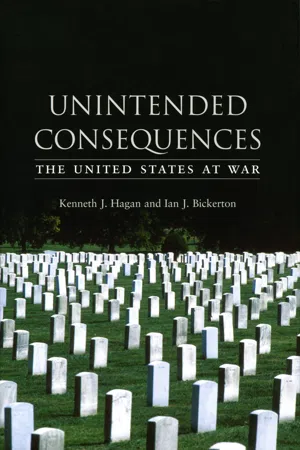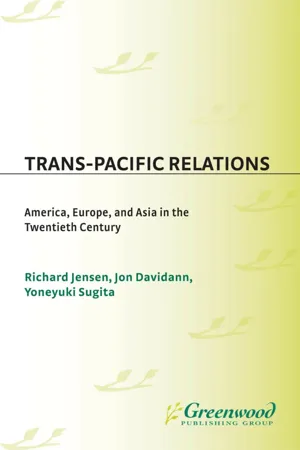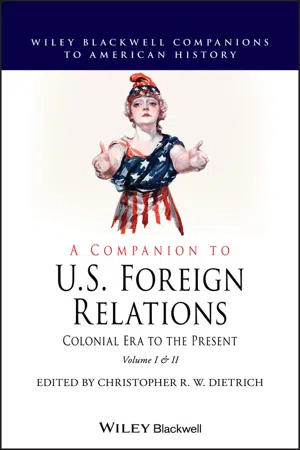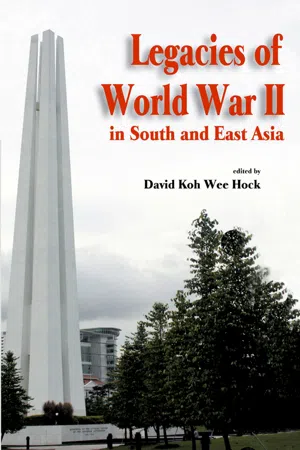History
US Involvement in WW2
The US involvement in WW2 began after the attack on Pearl Harbor in 1941, leading to the country's entry into the war. The US played a significant role in the Allied victory, contributing troops, resources, and military support to the war effort in Europe, Africa, and the Pacific. This involvement ultimately helped to shift the balance of power in favor of the Allies.
Written by Perlego with AI-assistance
Related key terms
1 of 5
6 Key excerpts on "US Involvement in WW2"
- eBook - ePub
Unintended Consequences
The United States at War
- Kenneth J. Hagan, Ian J. Bickerton(Authors)
- 2007(Publication Date)
- Reaktion Books(Publisher)
SEVENTHE UNITED STATES INWORLD WAR II , 1941–45
The world is heading toward a secret armament race of a ratherdesperate character.Henry L. Stimson to Harry S. Truman, 11 September 19451World War II was the most cataclysmic war in human history. This war unleashed darker passions, killed more people, and utilized more powerful and deadly weapons than any war in human experience. It was a war almost beyond comprehension in its totality, brutality, scale and scope. It was a war that defined peoples, nations and the twentieth century. In many ways, the sheer scale of the war has discouraged, if not prevented, a detached assessment of its meaning and consequences.If the United States held true to the idealism, utopianism and universal values espoused by Woodrow Wilson only two decades earlier, then World War II was a war that should have engaged the United States from its outbreak in Europe in 1939. If the realpolitik articulated by other American leaders had any lasting substance or significance beyond empty political rhetoric and hypocrisy, then the United States should have entered it without hesitation. If Americans believed in the efficacy of war – and they surely did – then their failure to act quickly and decisively at the onset of the European war contributed greatly to the magnitude of the war’s unintended consequences.Instead, the United States initially stayed aloof from the conflict engulfing the world, declaring itself neutral until attacked by Japan in December 1941. Or it appeared to stay aloof. In reality, President Franklin Delano Roosevelt involved the United States surreptitiously by assisting Great Britain in the European theatre. In the Far East he embargoed oil shipments to Japan, a policy he knew or believed would provoke Japan into an attack on American interests in the Pacific, necessitating an American armed response. In so doing, Roosevelt was following the example of President Wilson during World War I - eBook - PDF
A People and a Nation
A History of the United States
- Jane Kamensky, Carol Sheriff, David W. Blight, Howard Chudacoff(Authors)
- 2017(Publication Date)
- Cengage Learning EMEA(Publisher)
At war’s end, although many Americans grieved for loved ones lost in battle and worried about the stability of the emerging post- war order, the United States had unprecedented power and unmatched prosperity among the world’s nations. ■ What factors brought the United States into the war? ■ What military, diplomatic, and social factors influenced decisions about how to fight the Second World War? ■ How did World War II transform the United States? 23-1 America’s Entry into the Conflict ▶ ▶ How did Franklin D. Roosevelt draw the United States closer to war? ▶ ▶ How did American attitudes about involvement in the war evolve after 1939? ▶ ▶ What was the nature of the relationship between Japan and the United States prior to the bombing of Pearl Harbor? Winston Churchill British wartime prime minister; close friend of FDR and staunch ally of the United States; served 1940–1945 and 1951–1955. Copyright 2019 Cengage Learning. All Rights Reserved. May not be copied, scanned, or duplicated, in whole or in part. Due to electronic rights, some third party content may be suppressed from the eBook and/or eChapter(s). Editorial review has deemed that any suppressed content does not materially affect the overall learning experience. Cengage Learning reserves the right to remove additional content at any time if subsequent rights restrictions require it. CHAPTER 23 The Second World War at Home and Abroad | 1939–1945 668 (air force) launched massive bombing raids against Great Britain in preparation for a full-scale invasion. Alarmed by the swift defeat of one European nation after another, Americans increasingly questioned isolationist principles. Some liberals left the isolationist fold; it became more and more the province of conservatives. Emotions ran high. Roosevelt called the isolationists “ostriches” and charged that some were pro-Nazi subversives. More significantly, the president worked to prevent the fall of Britain. - eBook - PDF
- Keith A. Crawford, Stuart J. Foster(Authors)
- 2011(Publication Date)
- Information Age Publishing(Publisher)
It justified fleets of carriers patrolling the Mediterranean and the South China Sea, nuclear submarines under the polar icecap, air basis in the Thai jungle, and police advisers in Uruguay and Bolivia. In support of it an average of a million sol-diers were deployed for twenty-five years in some four thousand bases in thirty countries. 2 Of course, America’s prolific engagement in world affairs has endured well beyond the 25 years to which Hodgson refers. Emerging from the ashes of World War II, America’s controversial, and self-appointed, mission to act as the world’s conscience, savior, and policeman remains highly evi-dent in the opening decade of the 21st century. The significance of World War II in understanding America’s unique place in the world cannot be underestimated. Not surprisingly, the war enjoys a prominent position in American history education. Indeed, the presence of World War II in both world and U.S. high school history curriculum is guaranteed. HISTORY TEXTBOOKS AND U.S. EDUCATION The widespread acceptance of World War II as a significant topic of study in state curricula ensures that history textbooks generously cover wartime events. The principal aim of this chapter, therefore, is to provide a critical Ideology and Narrative 127 analysis of how the war is treated in American texts. As a prerequisite to this analysis it is important to understand the role and function of history textbooks in the American educational system. Throughout their school-ing American children regularly encounter historical topics typically sup-ported by an array of mass-produced textbooks. During their high school years, students often undertake yearlong courses in both U.S. and world history. 3 To assist their study every student is issued a substantial and weighty textbook typically consisting of 750 to 1,100 pages. The selection of textbooks for use in U.S. schools is a complex and often controversial process. - eBook - PDF
Trans-Pacific Relations
America, Europe, and Asia in the Twentieth Century
- Richard Jensen, Jon Davidann, Yoneyuki Sugita, Richard Jensen, Jon Davidann, Yoneyuki Sugita(Authors)
- 2003(Publication Date)
- Praeger(Publisher)
Part II American Entrenchment in Asia: World War II, Occupation, and Neo-Colonialism This page intentionally left blank Chapter 5 The Pacific War: An Interpretation Mark Parillo Historians' fascination with the Pacific episodes of World War II began even before the guns fell silent in 1945. Indeed, Samuel Eliot Morison un- dertook his massive study of U.S. Navy operations in World War II while the conflict still raged, and there has been no slackening in the study of the Pacific theater since. Among the many facets of the war that have intrigued and animated military historians are the impact of aerial operations on naval tactics, the development of amphibious doctrine and its inspired ex- ecution by the U.S. Marine Corps, Bushido and its influence on the conduct and strategic thinking of the twentieth-century samurai, and the awful ap- plication of American airpower in the Japanese home islands. Meanwhile, diplomatic historians have traced and retraced the steps along the path to Pearl Harbor, intelligence historians have marveled at the cryptanalytic as- pects of the war, and, more recently, cultural and social historians have explored the war as a racist struggle and as a contest between contrasting and colliding cultural traditions. The literature gushing forth from histo- rians' pens a half century after the war is impressive in both volume and variety, and there are few signs of any decrease in its rate of growth. We might also note that the academics' love affair with the war has been matched by a steady popular market for studies and stories of the great Pacific conflict. So, the strategy, the drama, the technology, and even the scale of the U.S.-Japanese military confrontation still have the power to fascinate, but we might attribute its enduring popularity among historians and the general readership as well to something else. - eBook - ePub
A Companion to U.S. Foreign Relations
Colonial Era to the Present
- Christopher R. W. Dietrich(Author)
- 2020(Publication Date)
- Wiley-Blackwell(Publisher)
Chapter Twenty U.S. Foreign Relations During World War IIAndrew JohnstoneThe historiography of U.S. foreign relations during World War II is vast. For the United States, the war was one of the defining events of the twentieth century, altering its place and role in the world ever since. Given the significant changes that came with it, the war continues to attract public interest. This is in no small part because of the perception of it as a “good war” against evil, and the fact it is still in living memory. Scholarly interest has been further supported over the years by a huge amount of available source material in the form of documents and memoirs. And while most of that material may now be openly available, historians continue to revisit previously examined events and to use different approaches to assess seemingly well‐known historical issues. Historians have also found new ways of examining sources, events, and actors that might once have been deemed tangential or even irrelevant. As a result, the literature continues to grow, and even if the surge of interest that followed the 50th and 60th anniversaries of the war's end has passed, it shows no sign of stopping soon.1The writing of history is always affected by the era in which it is written, and that has certainly been the case with World War II. Much of the early literature on the war was deeply entwined with the debates over the origins of the Cold War, and there is no question that many later books and articles reflect the political climate in which they were produced. In the decades since the end of the Cold War, those heated political debates have started to fade, though they have not vanished completely. As Mark Stoler (2014 ) has pointed out, while World War II and the Cold War are still linked, the former is increasingly seen on its own terms. It is not, as was once feared by Warren F. Kimball (2001 - David Koh(Author)
- 2007(Publication Date)
- ISEAS Publishing(Publisher)
138 Takashi Inoguchi Chapter Eleven How to Assess World War II in World History: One Japanese Perspective Takashi Inoguchi THE SIGNIFICANCE OF WORLD WAR II IN MODERN HISTORY This chapter assesses the impact of World War II through the following lenses: (1) World War II as a fight between democracy and Fascism; (2) winning World War II meant independence from colonial powers for many countries; and (3) World War II as another fight by democracy against tyranny. The chapter assesses the legacies of World War II especially as they relate to East and Southeast Asia. Lastly, it attempts to make a combined assessment from all these three lenses. THREE FACES OF WORLD WAR II Democracy against Fascism That the United States played a leading role in defeating Fascist allies in World War II is the standard narrative about the significance of World War II (Butow 1954, 1961; Gaddis 1987; Leffler 1992; Ikenberry 2000). One Japanese Perspective 139 According to this version, World War II was the war of democracy against Fascism embodied by Germany and Japan. All the Allied Powers fought against them, and the Soviet Union ruled by the Communist Party contributed no less immensely to the defeat of Fascism. Hence democracy was taken in a broad sense of the word. In other words, any kind of anti-Fascism was democracy, including anti-Fascism by people’s democracy, which was actually totalitarian rule. That was the broad understanding on the basis of which the United States, the Soviet Union, Great Britain, France and China were convened at Yalta in 1945 (Yergin, 1978). They were all also victors in World War II. France and China were not as strong as they wished in fighting this war in the first place. Yet to bring the semblance of unity and solidarity of all Allied Powers to the fore, the United States wanted to include all these five as parties to the Yalta accord. All five became the permanent members of the Security Council of the United Nations, which was founded in 1945.
Index pages curate the most relevant extracts from our library of academic textbooks. They’ve been created using an in-house natural language model (NLM), each adding context and meaning to key research topics.





